Abstract
Vegetables are an inevitable and important part of a healthy and balanced diet. They could be contaminated by heavy metals in many ways including irrigation by sewage water and industrial effluents sewage sludge, vehicular emissions, industrial waste and atmospheric deposition. In this study, we sought to determine if some vegetables (cucumbers, tomatoes, cabbage, lettuce, potatoes, onions, carrots, persian leeks, dill, spinach, coriander, parsley) grown locally in the suburban of Isfahan city and sold in the urban markets are contaminated with cadmium (Cd), chromium (Cr) and lead (Pb). Vegetables were sampled from August to October 2010. After washing, they were oven-dried and digested using three-acid mixture (70% HNO3, 65% HClO4 and 70% H2SO4). Analyzes of the heavy metals was performed using atomic absorption spectrophotometry. To validate the assay method, intra-day and inter-day variation studies were performed. The concentrations (μg/g) of heavy metals in the samples ranged from 0.00 to 3.66 for Cd, 0.00 to 6.00 for Cr and 0.00 to 7.14 for Pb. The highest concentration of heavy metals was for Pb. The results showed that the amount of Cd, Cr and Pb of some samples exceeded the recommended levels. The amount of Cd in cucumber, tomatoes, potatoes with skin, carrots, and spinach was significantly higher in the samples collected from Isfahanak, Dashti and Ilchi farms than those of Dorche farms. Also, the amount of Cr in onion, carrots, and spinach was significantly higher in samples collected from Isfahanak, Dashti and Ilchi farms than those of Dorche farms. However, the amount of Pb in the carrots and leek was significantly higher in the samples collected from Dorche farms than those of Isfahanak, Dashti and Ilchi farms. It can be concluded from the findings of this study that the amounts of Cd, Cr, and Pb were higher than the acceptable levels recommended by WHO/FAO. Also, higher amount of Cd and Cr in some samples collected from Isfahanak, Dashti and Ilchi farms compared to that of the samples collected from Dorche farms may indicate the influence of contaminants that enter ZayadeRood River as it passes Isfahan.
Keywords: Vegetables, Cadmium, Chromium, Lead
INTRODUCTION
Rapid urbanization and industrialization in many parts of the world would be the main reasons for contamination by metals in the terrestrial environment. This can influence the natural geochemical cycling of the ecosystem. Important sources for heavy metals contamination include: irrigation by sewage water and industrial effluents sewage sludge (1,2) , organic manures and composts (3) , vehicular emissions (4,5) , incinerators (6) , industrial waste, atmospheric deposition of heavy metals from point sources such as metaliferous mining, smelting and industrial activities (7,8,9). Factors which influence the concentration of heavy metals in plants include climate, atmospheric deposition, the nature of the soil on which the plant is grown and the degree of maturity of the plant at the time of harvesting (10,11,12). Repeated use of wastewater can overcome the capacity of the soil to retain heavy metals therefore; soil can release heavy metals into the ground water or soil solution available for plant uptake (13).
Airborne heavy metal contamination is becoming a great concern in different countries. The major source for airborne Pb is automobile exhausts and for Cd and zinc are smelting, fossil fuel combustion and waste incineration (14,15,16). As most of vegetable growing areas are situated in, or near sources of atmospheric deposits, the risk of potential contamination of them is high.
Contamination with metal is of great concern, particularly in agricultural production systems. Contamination with heavy metals which comes from the industries and vehicles may be deposited on the vegetable surfaces during their production, transport and marketing (17). It has been shown that contamination of vegetables is mainly by Pb, Cd, Cr and As (18).
As heavy metals are non-biodegradable and non thermo degradable and they have long biological half-lives, they will accumulate in the food chains which have significant effects on human health in the long term (19,20).
One of the most important aspects of food quality assurance is heavy metal contamination of the food items (21). As awareness of the risk of heavy metal contamination in food chain increases national and international regulations on food quality have lowered the maximum acceptable levels of toxic heavy metals in food items (22). A number of studies have shown heavy metals as important contaminants of the vegetables (23,24).
It has been shown that accumulation of heavy metals in the kidney and liver of humans may occur after prolonged exposure to unsafe concentrations of heavy metals through foodstuffs. Pregnant women or very young children are more vulnerable to heavy metal toxicity. Some of the important effects of heavy metal poisoning are neurological disorders, central nervous system destruction, and cancers of various body organs. They may cause disruption of several biochemical processes, leading to cardiovascular, nervous, kidneys and bone diseases. Also, there are some reports showing low birth weight and severe mental retardation of newborn children where during pregnancy mother exposed to toxic amounts of a heavy metal through direct or indirect consumption of vegetables (13,25).
Vegetables are important part of Iranian people's diet. The daily consumption of vegetables in Iran reported 278 g which is more than that of many other countries (26,27). This fact shows the importance of evaluating the safety of vegetables in aspect of heavy metal contamination. The aim of the present study was to determine the concentrations of heavy metals (Cd, Cr and Pb) in some vegetables (cucumbers, tomatoes, cabbage, lettuce, potatoes, onions, carrots, leeks, dill, spinach, coriander, parsley) grown locally in the suburban of Isfahan city and sold in the urban markets.
MATERIALS AND METHODS
Materials
Following reagents used in this work were purchased from Merck (Germany): K2CrO4, CdCl2, PbNO3, HNO3, HClO4, H2SO4 (Merk, Germany). All reagents were of analytical grade.
Sample collection and preparation
This study was carried out between August and October 2010 in Isfahan, Iran. Isfahan is the third populated city of Iran with a dry climate. There are several industries located at the periphery of the city. Zayandeh-Rood river crosses Isfahan from west to east. The main source of water for the irrigation of the farms in this region is Zayandeh-Rood river. The study site comprised of two regions, one located on the west (Dorche farms) and the other on the east (Isfahanak, Dashti and Ilchi farms) of Isfahan. Also, t wo multipurpose retail markets were sampled of which one is located on the sought west (Valieasr) and the other on the north east (Soroush) of the city of Isfahan. The vegetables sampled include cucumbers, tomatoes, cabbage, lettuce, potatoes, onions, carrots, leeks, dill, spinach, coriander and parsley (Table 1).
Table 1.
Vegetables sampled from various farms as well as retailed local markets
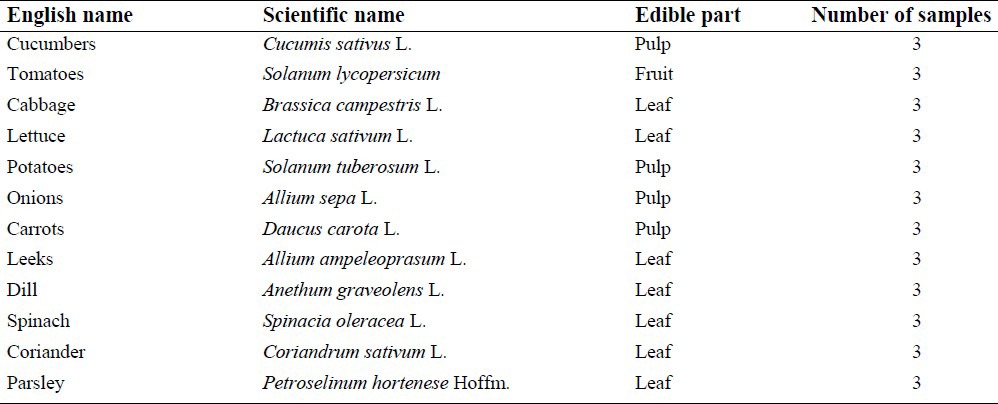
Samples of vegetables were collected from different outlets in each market locations and from farms. Samples were kept in pre-distilled water-rinsed polyethylene bags, labeled and brought back to the laboratory. The edible portions of the vegetables were separated. To eliminate soil and air-born pollutants, samples were washed under clean tap water and then with distilled water. They were then chopped into small pieces and oven dried at 80°C until the constant weight was achieved. The dried samples were powdered with a stainless steel blender and kept at clean, dry, stoppered glass containers at room temperature for further analysis.
Preparation of standard solutions
Standard solutions of Cd and Cr (1000 ppm) were prepared by dissolving 3.735 g of K2CrO4 or 1.631 g of CdCl2 in 1000 ml doubled distilled deionised water, respectively. Standard Pb solution (1000 ppm) was prepared by dissolving 1.598 g of PbNO3 in nitric acid (1%) followed by double distilled water upto 1000 ml. The working solutions (0.01-0.5, 0.1-10 and 0.1-5 ppm of Cd, Cr and Pb, respectively) were prepared just before the use by dilution of the standard solution with redistilled water. The absorbance of standard solution was determined by an atomic absorption spectrophotometer (Perkin-Elmer). Wavelength and slit width for heavy metals measured are shown in Table 2.
Table 2.
Wavelength and slit width of each heavy metal measured

Sample preparations
A working solution of H2SO4 (65%), HClO4 (65%) and HNO3 (70%) with ratio of 1:1:5 was prepared and used for digestion of the samples. One g of dry powder of each sample was digested using 15 ml of aforementioned three-acid mixture and then heated at 80 °C till the solution became transparent (24). The resulting solution was cooled, filtered (with whatman filter paper No.41) and diluted to 50 ml using double distilled water. The samples were analyzed for Cd, Cr and Pb. Different working solutions containing the same amount of three-acid mixture (70% HNO3, 65% HClO4 and 70% H2SO4) were prepared to see the effects of digesting solution on the results.
Statistical analysis
SIGMASTAT™ (Jandel Software, San Raphael, CA) was used to perform statistical tests. Analysis of variance followed by Kruskal-Walis test was used to determine the differences. Significance was assumed at the 5% level.
RESULTS
Standard curves of Cd, Cr, and Pb showed a good linear relationship between concentrations of the heavy metals and respective absorbances (Table 3).
Table 3.
Equations and regression parameters of the calibration curve generated for Cd, Cr, and Pb

The accuracy of the methods was validated by comparing the actual amounts of Cd, Cr or Pb with those of calculated concentrations. The intra-day precision and accuracy of the method were determined under the optimal working conditions by triplicate measurements of known Cd, Cr or Pb concentrations. For the determination of inter-day precision and accuracy, the same procedure was repeated over a 3-day period. The findings for intra-day and the inter-day variation are illustrated in Table 4–6.
Table 4.
Intra-day and inter-day variation for Cd measurements

Table 6.
Intra- and inter-day variation for Pb

Table 5.
Intra- and inter-day variation for Cr

The percent dry weight of samples is shown in Table 7. The amount of heavy metals (Cd, Cr and Pb) found in the vegetables samples are presented in Tables 8–10, respectively. The concentrations (μg/g) of the heavy metals in samples ranged from 0.00 to 3.66 for Cd, 0.00 to 6.0 for Cr and 0.00 to 7.14 for Pb. Our findings showed that the highest concentration of heavy metals was for Pb. In accordance with the standard guideline of FAO/WHO, it was found that Cd, Cr and Pb concentrations of some samples exceeded the recommended levels. The amount of Cd in cucumber, tomatoes, and potatoes with skin, carrots, and spinach was significantly higher in samples collected from Isfahanak, Dashti and Ilchi farms than those of Dorche farms. Also, the amount of Cr in the onion, carrots, and spinach was significantly higher in samples collected from Isfahanak, Dashti and Ilchi farms than those of Dorche farms. However, the amount of Pb in the carrots and leek was significantly higher in samples collected from Dorche farms than those of Isfahanak, Dashti and Ilchi farms.
Table 7.
Percent of dry weight of the vegetables sampled
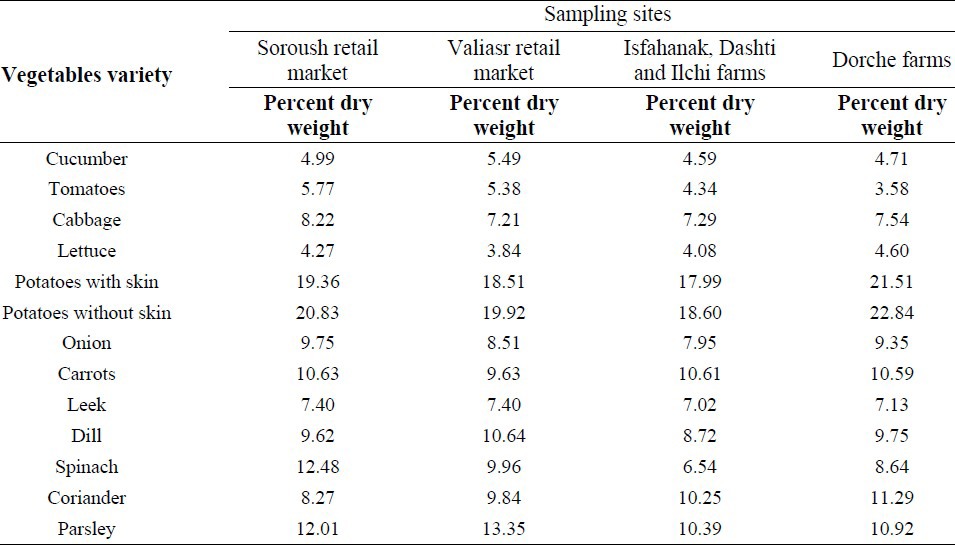
Table 8.
Concentrations of Cd in the vegetables sampled
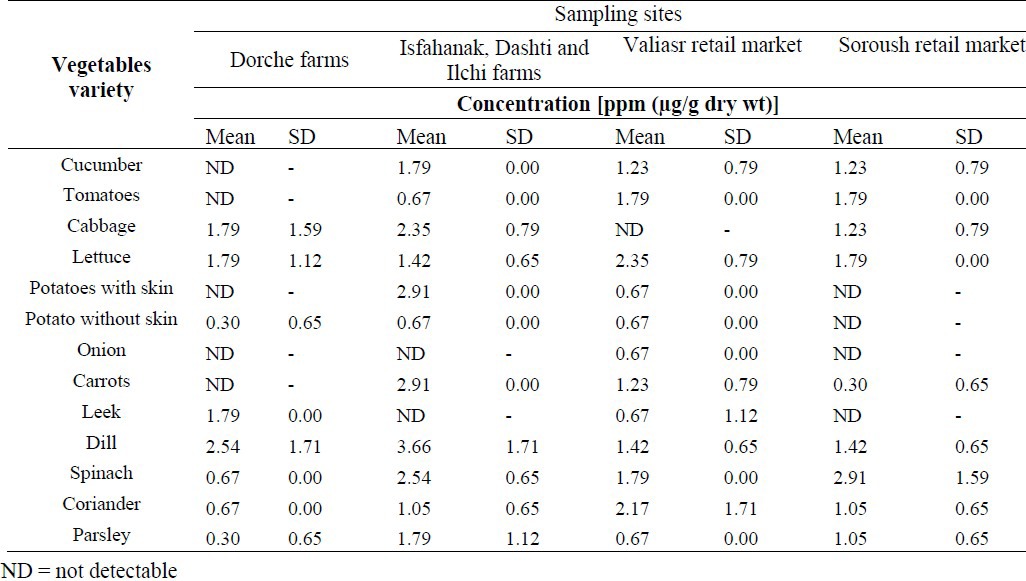
Table 10.
Concentrations of Pb in the vegetables sampled
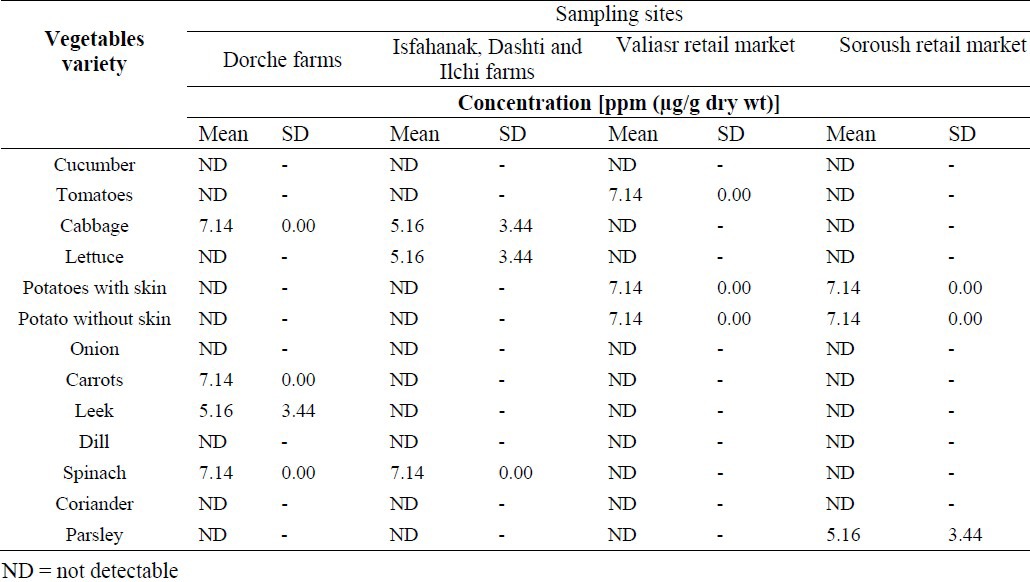
Table 9.
Concentrations of Cr in the vegetable samples
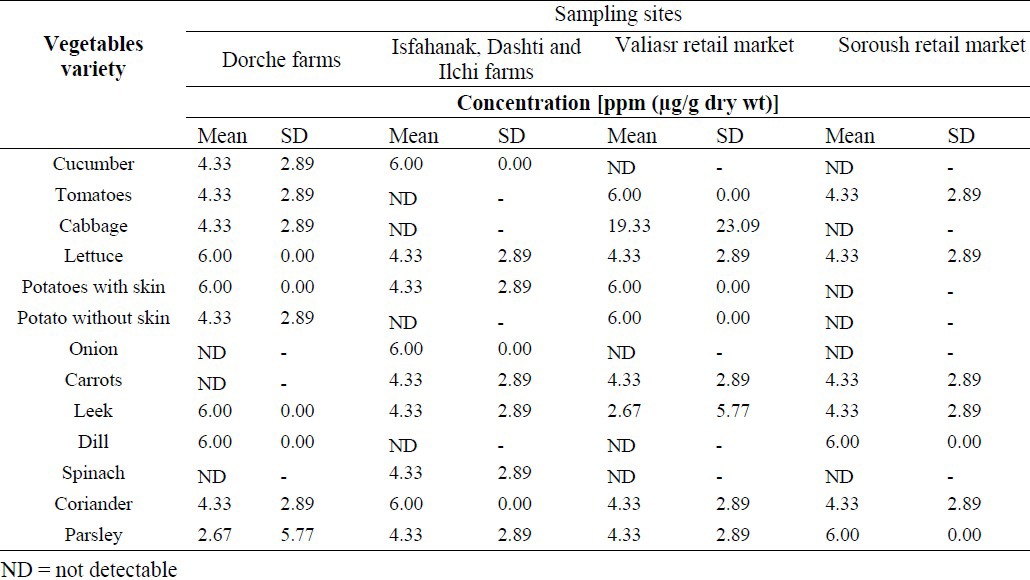
DISCUSSION
Urbanization and industrialization in many parts of the world have increased the presence of metals into the terrestrial environment which have potential health impacts of consuming contaminated products such as vegetables. In this study, samples of vegetables from surban farms and two retail markets of Isfahan city were collected in 2010 and analyzed for Cd, Cr and Pb using atomic absorption spectrophotometry. Our goal was to determine the contamination of vegetables by these metals.
Isfahan is the third populated city in Iran with dry climate. There are several industries located at the periphery of the city which makes the possibility of contamination with heavy metals higher than that of most cities of Iran. Zayandeh-Rood river crosses Isfahan from west to east. The main source of water for the farms in this region is Zayandeh-Rood river. The study site comprised of two regions, one located on the west (Dorche farms) and the other on the east (Isfahanak, Dashti and Ilchi farms) of Isfahan. Also, two multipurpose retail markets were sampled one located on the sought west (Valieasr) and the other on the north east (Soroush) of Isfahan city.
Gharib and coworkers showed that the daily intake of Cd, Cr and Pb in Iranian women was about 0.027, 0.05 and 0.091 mg, respectively and in Iranian men was about 0.046, 0.050 and 0.109 mg, respectively (26). WHO/FAO recommended a minimum of 400g of fruit and vegetables per day (excluding potatoes and other starchy tubers) for the prevention of chronic diseases such as heart disease, cancer, diabetes, and obesity (28). According to the National Nutrition and Food Research Institute of Iran, the average consumption of edible vegetables is 218 g/person/day. Although, it is less than the recommended level, it is more than those of many countries (29). Therefore, vegetables contamination with heavy metal could be an important concern in Iranian suggesting periodical monitoring of them in the human food chain.
Our findings showed that the amount of Cd in cucumber, tomatoes, potatoes with skin, carrots, and spinach was significantly higher in the samples collected from Isfahanak, Dashti and Ilchi farms than those of Dorche farms. Also, the amount of Cr in the onion, carrots, and spinach was significantly higher in the samples collected from Isfahanak, Dashti and Ilchi farms than those of Dorche farms. As Zayande-Rood river passes through the Isfahan city, more contaminants enter the river which may explain the higher amount of Cd and Cr in some samples collected from Isfahanak, Dashti and Ilchi farms. It is worthwhile to point out that the main source for irrigation of vegetables in Isfahan is Zayande-Rood River. However, the amount of Pb was significantly higher in carrots and leek samples collected from Dorche farms than those of Isfahanak, Dashti and Ilchi farms. Different studies have shown that there was significant differences between vegetables of various cities and villages (30).
Our findings showed that the highest concentration of heavy metals was for Pb. In comparison with the standard guideline of FAO/WHO, it was found that Cd, Cr and Pb concentrations of some samples exceeded the recommended levels. These findings are in agreement with those of Mahdavi who showed that the heavy metal concentration of vegetables from Babasalman and Eslamshahr regions in Tehran (capital of Iran) were higher than the recommended levels of FAO/WHO (31).
CONCLUSION
It can be concluded, from the findings of this study, that the amounts of Cd, Cr, and Pb were higher than the acceptable levels recommended by WHO/FAO. Also, higher amount of Cd and Cr in some samples collected from Isfahanak, Dashti and Ilchi farms compared to those of the samples collected from Dorche farms may indicate the influence of contaminants that enter Zayadeh-Roodr river as it passes Isfahan city. Due to the importance of this issue and changes in the sources of contamination, it is recommended to conduct studies with this nature periodically.
ACKNOWLEDGMENT
This study was supported by a grant from the Research Council of Isfahan University of Medical Sciences, Isfahan, Iran.
REFERENCES
- 1.Culbard EB, Thornton I, Watt J, Wheatley M, Moorcroft S, Thompson M. Metal contamination in British urban dusts and soils. J Environ Qual. 1988;17:226–234. [Google Scholar]
- 2.Mireles A, Solís C, Andrade E, Lagunas-Solar M, Pinña C, Flocchini RG. Heavy metal accumulation in plants and soil irrigated with wastewater from Mexico City. Nucl Instrum Meth Phys Res B Beam Interact Mater Atoms. 2004;219-220:187–90. [Google Scholar]
- 3.Singh B. Heavy metals in soils: sources, chemical reactions and forms. In: Smith D, Fityus S, Allman M, editors. ‘GeoEnvironment: Proceedings of the 2nd Australia and New Zealand Conference on Environmental Geotechnics: Australian Geochemical Society: Newcastle, Newcastle, New South Wales’; 2001. pp. 77–93. [Google Scholar]
- 4.Harrison RM, Laxen DPH, Wilson SJ. Chemical associations of lead, cadmium, copper, and zinc in street dusts and roadside soils. Environ Sci Technol. 1981;15:1378–1383. [Google Scholar]
- 5.Hashisho Z, El-Fadel M. Impacts of traffic-induced lead emissions on air, soil and blood lead levels in Beirut. Environ Monit Assess. 2004;93:185–202. doi: 10.1023/b:emas.0000016804.88534.34. [DOI] [PubMed] [Google Scholar]
- 6.Schuhmacher M, Meneses M, Granero S, Llobet JM, Domingo JL. Trace element pollution of soils collected near a municipal solid waste incinerator: human health risk. Bull Environ Contam Toxicol. 1997;59:861–867. doi: 10.1007/s001289900561. [DOI] [PubMed] [Google Scholar]
- 7.Kuang C, Neumann T, Norra S, Stuben D. Land use-related chemical composition of street sediments in Beijing. Environ Sci Pollut Res. 2004;11:73–83. doi: 10.1007/BF02979706. [DOI] [PubMed] [Google Scholar]
- 8.Thornton I. Metal contamination of soils in urban areas. In: Bullock P, Gregory PJ, editors. Soils in the urban environment. Blackwell; 1991. pp. 47–75. [Google Scholar]
- 9.Banat KM, Howari FM, Al-Hamad AA. Heavy metals in urban soils of central Jordan: should we worry about their environmental risks? Environ Res. 2004;97:258–273. doi: 10.1016/j.envres.2004.07.002. [DOI] [PubMed] [Google Scholar]
- 10.Lake DL, Kirk PWW, Lester JN. The fractionation, characterization and speciation of heavy metals in sewage sludge and sewage sludge amended soils. J Environ Qual. 1984;13:175–183. [Google Scholar]
- 11.Scott D, Keoghan JM, Allan BE. Native and low-input grasses-a New Zealand high country perspective. NZJ Agric Res. 1996;39:499–512. [Google Scholar]
- 12.Voutsa D, Grimanis A, Samara C. Trace elements in vegetables grown in an industrial area in relation to soil and air particulate matter. Environ Pollut. 1996;94:325–335. doi: 10.1016/s0269-7491(96)00088-7. [DOI] [PubMed] [Google Scholar]
- 13.Kumar JI, HirenSoni, Rita N Kumar. Characterization of Heavy Metals in Vegetables Using Inductive Coupled Plasma Analyzer (ICPA) J Appl Sic Environ. 2007;11:75–76. [Google Scholar]
- 14.Washington, DC: 1972. National Academy of Sciences. Airborne lead in perspective. [Google Scholar]
- 15.Washington, DC: 1977. Us Environmental Protection Agency. Air quality criteria for lead. [Google Scholar]
- 16.Varma MM, Katz HM. Environmental impact of cadmium. J Environ Health. 1978;40:324–329. [Google Scholar]
- 17.Jassir MS, Shaker A, Khaliq MA. Deposition of heavy metals on green leafy vegetables sold on roadsides of Riyadh city, Saudi Arabia. Bull Environ Contam Toxicol. 2005;75:1020–1027. doi: 10.1007/s00128-005-0851-4. [DOI] [PubMed] [Google Scholar]
- 18.Gupta UC, Gupta SC. Trace element toxicity relationships to crop production and livestock and human health: Implication for management. Commun Soil Sci Plant Anal. 1998;29:1491–1522. [Google Scholar]
- 19.Alloway BJ. Blackie. London: 1990. Heavy metals in soils. [Google Scholar]
- 20.Kabata-Pendias A, Pendias H. 2nd edition. Boca Raton, Florida: CRC Press; 1992. Trace elements in soils and plants. [Google Scholar]
- 21.Khan S, Cao Q, Zheng YM, Huang YZ, Zhu YG. Health risk of heavy metals in contaminated soils and food crops irrigated with waste water in Beijing, China. Environ Pollut. 2008;152:686–692. doi: 10.1016/j.envpol.2007.06.056. [DOI] [PubMed] [Google Scholar]
- 22.Radwan MA, Salama AK. Market basket survey for some heavy metals in Egyptian fruits and vegetables. Food Chem Toxicol. 2006;44:1273–1278. doi: 10.1016/j.fct.2006.02.004. [DOI] [PubMed] [Google Scholar]
- 23.Sharma RK, Agrawal M, Marshall F. Heavy metal contamination of soil and vegetables in suburban areas of Varansi, India. Ecotoxicol Environ Saf. 2007;66:258–266. doi: 10.1016/j.ecoenv.2005.11.007. [DOI] [PubMed] [Google Scholar]
- 24.Jarup L. Hazards of heavy metal contamination. Br Med Bull. 2003;68:167–182. doi: 10.1093/bmb/ldg032. [DOI] [PubMed] [Google Scholar]
- 25.Sharma RK, Agrawal M, Marshall FM. Heavy metals (Cu, Cd, Zn and Pb) contamination of vegetables in Urban India: a case Study in Varanasi. Environ Poll. 2008;154:254–263. doi: 10.1016/j.envpol.2007.10.010. [DOI] [PubMed] [Google Scholar]
- 26.Gharib AG, Fatoorechian S, Ahmadiniar A. Determination of essential major and trace elements in daily diets by comparative methodologies and alterations. Trace Elements Med. 2003;1:43–53. [Google Scholar]
- 27.Alam MGM, Snow ET, Tanaka A. Arsenic and heavy metal contamination of vegetables in Samta village, Bangladesh. Sci Total Environ. 2003;308:83–96. doi: 10.1016/S0048-9697(02)00651-4. [DOI] [PubMed] [Google Scholar]
- 28.Global strategy on diet, physical activity and health, Promoting fruit and vegetable consumption around the world. http://www.who.int/dietphysicalactivity/fruit/en .
- 29.Maleki A, Alasvand Zarasvand M. Heavy metals in selected edible vegetables and estimation of their daily intake in sanandaj, Iran. Southeast Asian J Trop Med Public Health. 2008;39:335–340. [PubMed] [Google Scholar]
- 30.Demirezen D, Aksoy A. Heavy metal levels in vegetables in Turkey are within safe limits for Cu, Zn, Ni and exceeded of Cd and Pb. Food Qual. 2006;29:252–265. [Google Scholar]
- 31.Mahdavi ES. Determination of Pb, Ni, Hg, Cr, Cd in edible vegetables in the West South of Tehran province with atomic absorption. Res J Environ Sci. 2009;3:339–344. [Google Scholar]


